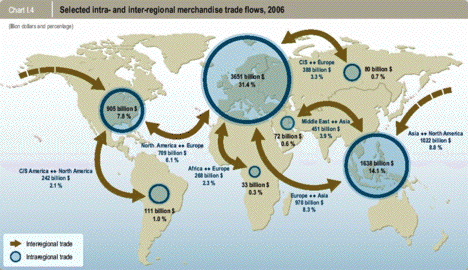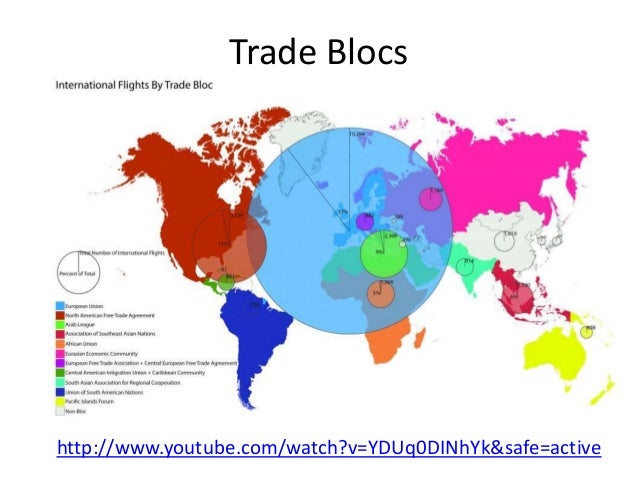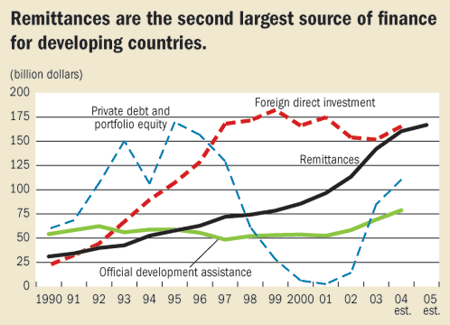Reducing disparities
Trade and market access
As trade expands the markets of MEDCs and LEDCs grow closer and this integration may bring and increase in the later's income, helping generating jobs, raising standards of living and eventually speed up the economic and social development process.
Source: http://www.sln.org.uk/geography/schools/blythebridge/GCSEDevelopmentTrade.htm
Source: http://greenfieldgeography.wikispaces.com/Financial+flows
Source: http://www.slideshare.net/maggiesalgado/trade-28758752
However, over the past few decades there has been a change in the trade pattern between MEDCs and LEDCs expressed above as many developing countries have strated to produce and export manufactues goods positively influencing their employment structure, balance of trade and ultimately their standard of living.
Source: https://www.weforum.org/agenda/2015/07/how-to-boost-africas-light-manufacturing-sector/
Trading bloc: A group of countries who have joined together to promote trade. This might be through relaxing protectionist barriers or even having a common currency. Examples of trading blocs include the EU, NAFTA and ASEAN.
Source: http://greenfieldgeography.wikispaces.com/Reducing+disparities
Source: http://www.slideshare.net/rcwells/trade-blocs-and-global-networks
Source: http://www.thanhniennews.com/business/transpacific-pact-to-reshape-stock-portfolios-alongside-trade-flows-47596.html
Free trade zones (Export processing zones or Enterprise zones): A zone or area where tariffs and quotas maybe waivered, taxes lowered, planning relaxed and bureaucracy eased to try and encourage investment and FDI.
BENEFITS OF FREE TRADE
|
BENEFITS OF PROTECTIONISM
|
- Gives local companies a chance to become global companies (TNC) e.g. Pollo Campero
- Countries who participate in free trade grow faster
- Protectionism makes products more expensive and may stop normal citizens from buying them e.g. cars in El Salvador are very expensive because of import duties
- Local companies can create pollution just as much as TNCs and may not have the money to clean up accidents e.g. BP created a huge spill but had the finances to clean up
- Mexico has increased its exports since joining NAFTA
- Trading can improve relationships between countries
- Countries with trading relationships are less likely to go to war
- Jobs are created for local workers
- Workers may improve skill and education level
- Infrastructure like roads and ports are improved for the whole country
- Laws can be put in place to protect worker rights
- More money can be made by selling to external markets rather than just domestic market
- Residents have access to greater variety of products
- Companies will become more competitive and should actually lower prices
- It is hard for countries to be self-sufficient because they may lack fertile soils or fossil fuels - they need to trade to survive and grow
|
- TNCs may take over local producers e.g. Walmart moving into El Salvador and taking over local supermarkets
- Workers are often exploited by TNCs and paid low wages for long hours
- Countries may become dependent on foreign countries imports e.g. Europe relies on Russian gas
- Countries may become reliant on foreign workers e.g. UAE rely on European, South Asian and Filipino workers
- Producing locally should reduce transport costs and certainly reduce air miles
- Local companies will use more appropriate technology and take greater care of the environment
- The most skilled jobs will be taken by foreign workers and may lead to unemployment
- Much of the profits will go overseas e.g. economic leakage e.g. Hiper Piaz profits go back to Walmart in US
- TNCS often don’t care about the environment of other countries and may cause pollution e.g. Union Carbide in Bhopal, India
- Fast food franchises like Starbucks and Burger King may cause local traditional restaurants to close
- Fast food restaurants may worsen people’s diets
- TNCs may close factories during economic recessions leading to unemployment
- Countries may be forced to change policies to suit TNCs e.g. lower taxes.
|
Source: http://greenfieldgeography.wikispaces.com/Reducing+disparities

Source:http://www.sjgrand.cn/china-shanghai-pilot-free-trade-zone-how-does-one-benefitDebt relief
Debt relief
Source: http://businesskorea.co.kr/english/news/politics/6853-government-debt-korean-govt-debt-exceeds-115-percent-national-gdp
Even though Japan has the highest ratio of debt to GDP, the US probably has the world's biggest debt at about 15 trillion dollars. Even though this is a massive amount of money, in terms of debt repayments (debt service), the US is spending a much smaller percentage of its GDP than many smaller poorer countries. The US currently spends around 10% of GDP on debt service, although this is expected to increase to about 15%.
For example during the 1990's Nicaragua in Central America had the largest per capita debt in the world. In the late 1990's Nicaragua had a debt of $6.1 billion, which equated to about $1,300 per capita. The government had to spend half its revenue on service debt (paying interest on debt). So even though Nicaragua's total debt was a fraction of the US's it was financially in a much worse position.
Source: http://greenfieldgeography.wikispaces.com/Reducing+disparities
Source: http://www.who.int/immunization/programmes_systems/financing/analyses/debt_relief/en/
The HIPC Initiative was launched in 1996 by the IMF and World Bank, with the aim of ensuring that no poor country faces a debt burden it cannot manage. Since then, the international financial community, including multilateral organizations and governments have worked together to reduce to sustainable levels the external debt burdens of the most heavily indebted poor countries.
In 1999, a comprehensive review of the Initiative allowed the Fund to provide faster, deeper, and broader debt relief and strengthened the links between debt relief, poverty reduction, and social policies.
In 2005, to help accelerate progress toward the United Nations Millennium Development Goals (MDGs), the HIPC Initiative was supplemented by the Multilateral Debt Relief Initiative (MDRI). The MDRI allows for 100 percent relief on eligible debts by three multilateral institutions—the IMF, the World Bank, and the African Development Fund (AfDF)—for countries completing the HIPC Initiative process. In 2007, the Inter-American Development Bank (IaDB) also decided to provide additional (“beyond HIPC”) debt relief to the five HIPCs in the Western Hemisphere.
Source: https://www.imf.org/external/np/exr/facts/hipc.htm
Aid
Emergency aid: Help that is given to a country that is suffering from a natural disaster or conflict. Emergency aid may include food, water, tents, clothing or even rescue teams to look for victims of natural disasters.
Development aid: Aid that is given to benefit the country. This might be money given to build a new road or port to improve infrastructure or money given to build a new hospital or school to benefit the people of a country.
|
TRADE
|
AID
|
ADVANTAGES
|
- Increased trade can create domestic jobs which increases tax revenue and reduces welfare costs.
- A free trade economy may attract foreign direct investment (FDI) which can create new jobs, improve infrastructure, etc.
- Trade ensures that countries don't become dependent on other countries or tied to other countries policies.
- Trade is a long-term solution that creates jobs, income, investment and training for the foreseeable future where aid tends to be short term fixes.
- Trade allows countries to compete on an equal footing with other countries around the world. Instead of being dependent on others, they are actually contributing to the global market. This increases countries and individuals self-esteem.
- It allows countries to buy and access products that they don't have themselves or are unable to produce themselves.
- Trade can improve relations between foreign powers.
|
- After a natural disaster, food and medical aid can be vital in saving lives and can not always be provided by the affected government.
- Aid can help build expensive infrastructure products that wouldn't normally be built e.g. new roads, ports, irrigation projects or HEP stations.
- Can help build schools and hospitals that improve the health and education of local populations.
- Many aid agencies employ local workers to carry out projects. This not only creates employment but teaches local new skills. This is especially true of bottom-up aid where locals are fully involved and make all key decisions.
- Many charities provide education about hygiene, diet and health. These schemes are not creating dependency, because they are not necessarily giving money, but do improve the well-being of societies.
|
DISADVANTAGES
|
- Many countries have protectionist policies which make it hard to compete.
- Many LEDCs trade in low value primary products which may cause them to build up a large trade deficit.
- Some countries lack raw materials so find it hard to trade without importing large quantities of raw materials.
- Emerging markets may be flooded with cheap foreign imports, destroying local businesses.
- TNCs can move into new emerging markets and exploit resources and workers.
- TNCs can destroy local culture by flooding the market with foreign products e.g. Starbucks and McDonald's
- During periods of economic downturn TNCs will leave foreign countries first often creating unemployment and leaving shortages of products.
- If the balance of trade (imports and exports) is uneven then a large deficit may develop. Also countries may be effectively blackmailed when the exchange is uneven e.g. Russia can blackmail the Ukraine over the supply of gas.
- Trade can cause environmental damage e.g. deforestation and carbon emissions from transportation can cause pollution
|
- Countries can become dependent on money given by foreign donors instead of developing their own economy to become independent.
- Aid money does not always reach the most needy and instead is taken by corrupt officials. Some aid like medicine can also get help up by bureaucracy and actually be out of date by the time it reaches the intended recipients. Kleptocratic (corrupt) governments may also take money for themselves and not give it to the people that need it.
- Tied aid can force country's to carry out policies that are not necessarily beneficial to the country. Also many of the contracts might go to companies from donor countries, so the receiving country is not receiving the full benefit in terms of jobs, training and income. The IMF had structural adjustment programmes which forced countries to make harmful economic changes in order to get loans.
- Food aid or worse food dumping, can force local food production to collapse. Often food is dumped when it is not needed. This undercuts the local food market and takes local farmers out of business. (US urged to stop Haiti rice subsidies - BBC article)
- Aid may stop because of political changes in donor country or receiving country or because of economic downturns. However, the UK has protected its development budget in the current economic downturn
- Aid might fund inappropriate and/or harmful technologies that can not be sustained after aid has been removed e.g. Nuclear power. Other projects like roads and dams can cause large scale environmental problems.
- Aid sometimes takes the forms of loans which can lead to high levels of debt. Many African countries borrowed large amounts of money off the IMF and World Bank and now have huge debt problems.
|
Source: http://greenfieldgeography.wikispaces.com/Reducing+disparities
Source: http://www.globalpost.com/dispatch/news/politics/aid/140811/charts-us-foreign-aid-requests-2015
Difference Between Top-down development and Bottom-up development
| Top-down Development: Development that is led by international organisations who dictate and implement policies and schemes with little local input. | Bottom-up Development: Development that is run by local communities for the benefit of the community. |
- Usually large scale policies or schemes
- Usually carried out by governments or international organisations
- Work is often carried out by outside contractors
- Schemes usually have plenty of funding.
- Often quick to respond after natural disasters
- Local people are often not consulted in decision making
- Schemes are not always appropriate and not always sustainable long term because of lack of local knowledge.
|
- Usually small scale initiatives
- Involves more local communities and local workers. The schemes are usually led by the local people themselves
- Projects are often labour intensive and for the benefit of the local community e.g building a well or repairing irrigation ditches.
- Funds are very limited
- Teach local people new skills
- Schemes are appropriate and sustainable long-term.
|
Source: http://greenfieldgeography.wikispaces.com/Reducing+disparities
Remittances
A remittance is the funds an expatriate sends to their country of origin via wire, mail, or online transfer. These peer to peer transfers of funds across borders are economically significant for many countries that receive them.
Source: http://www.investopedia.com/terms/r/remittance.asp#ixzz491fDXH7f
Source: http://www.imf.org/external/pubs/ft/fandd/2005/12/picture.htm
Source: http://im-an-economist.blogspot.com.br/2012/05/graph-of-week-remittances.html
Advantages of Remittances and Migration
- Reduces unemployment
- Reduces pressure on schools and hospitals (if migrants take children)
- Reduces pressure on infrastructure (houses, water , electricity, transport)
- Remittances go directly to friends and family so enter economy at local level
- Migrants can return with new skills (language, ICT)
- Improved relations with countries (Barack Obama recently visited El Salvador)
Disadvantages of Remittances and Migration
- Remittances fall during economic downturn. This is probably the time remittances are most needed
- It can create dependency i.e. a family relying on one or two members living abroad
- Creates family division and family pressure/conflict (the need to provide!)
- Increased dependency ratio in losing country, placing pressure on government
- Brain drain. Usually the youngest, most educated and skilled choose to leave.
- Reduces incentive of government to invest in education and job provision
- Migrants are open to extortion (family members maybe threatened for money or migrants might lose money on exchange rates/transfer fees)
Source: http://greenfieldgeography.wikispaces.com/Reducing+disparities















Geography For The Ibdp Wiki: 2. Disparities In Wealth And Development - Reducing Disparities >>>>> Download Now
ReplyDelete>>>>> Download Full
Geography For The Ibdp Wiki: 2. Disparities In Wealth And Development - Reducing Disparities >>>>> Download LINK
>>>>> Download Now
Geography For The Ibdp Wiki: 2. Disparities In Wealth And Development - Reducing Disparities >>>>> Download Full
>>>>> Download LINK Le